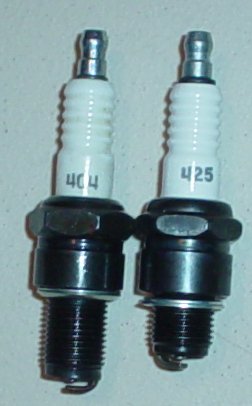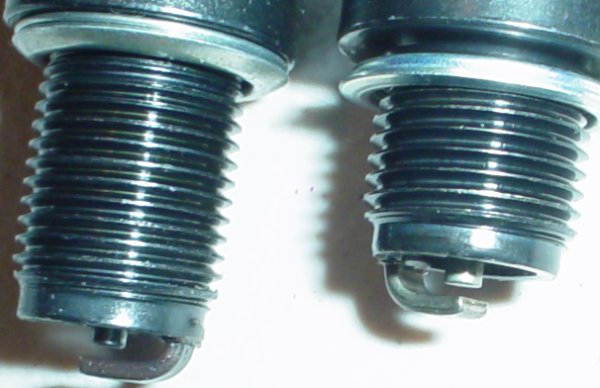Sorry about the gap in posting; the end of September is the end of the federal fiscal year, and so as usual at this time of the year, I have the Annual Progress Report to finish and send off. I have to send off my bits by tomorrow, so that'll be done.
I went out the other day to get spark plugs for the new head that I got for my Beetle. It got me interested in the different types of spark plugs and what they're for. The place I ordered the new head from told me that the spark plug holes in new heads made in Mexico are deeper than the originals (most likely because the originals would eventually crack there). So for the time being, I will need to have two plugs original length in the left side of the engine, and two longer ones on the right for the new head:

Spark Plug specifications are really complicated, and every company has a completely different numbering system to indicate the various features of their plugs. I did run across a cross-reference online that was useful. Many of the differences have to do with what type of thread is on the plug, or what the seat is, or whether or not the plug has a resistive core to cut down on radio frequency interference. However, there's one specification that is very important to the longevity of the plug and the running of the engine, that's the "heat" of the plug.
Since spark plugs ignite the fuel-air mixture in the cylinder, they are automatically one of the hottest parts of the engine. They get fairly hot, and it's important for them to be able to dissipate the combustion head as the engine is running. However, it's also important for the plug to not get too cold, either. One of the consequences of being hot is that there's a lot of chemical reactions going on right there. There is lots of cruddy stuff that tends to plate itself on all the parts of the combustion chamber, including the spark plug. The plug being hot keeps the deposits burned off so that it still acts efficiently as a spark gap. If the plug runs TOO hot, though, it ends up being an ignition source just from its heat, which is very bad, and it tends to be eroded away and not work at all, which is bad too.
Here are a couple of close-up views of those plugs.


The tip of the plug (the sort of button-thing in the middle) is the part that gets the hottest and needs to burn deposits off. You'll notice that the plug tip sits at the end of a long ceramic cone that goes up into the plug. The length of that code determines the "heat" rating of the plug. A "cold" plug is one that has a very short cone, which conducts head to the metal barrel of the spark plug and thus to the rest of the engine relatively well. A "hot" plug has a very long cone and conducts heat more poorly, and so tends to run hotter. The ideal case is that the plug is from 500-800 degress F while the engine is running. If the engine runs hotter, then the plug needs to be "colder" so that its final temperature ends up in about the right range.
My new favorite VW parts place has a very nice Bosch plug page that gives just the options that are most likely relevant for people driving VWs. There are basically four Bosch spark plug codes that are relevant: W8AC for stock beetle engines, W8CC for standard engines with long threads, W7AC for short thread engines that run hotter (higher compression, perhaps), and W7CC for hotter engines with longer threads.
In addition to their primary function, being an ignition source, plugs also have a seconary function of being a diagnostic tool. They are a piece of the combustion chamber that can be removed without taking out the engine, so if something (mixture, for instance) is dreadfully wrong, you can look at the plugs to see if they contain clues.